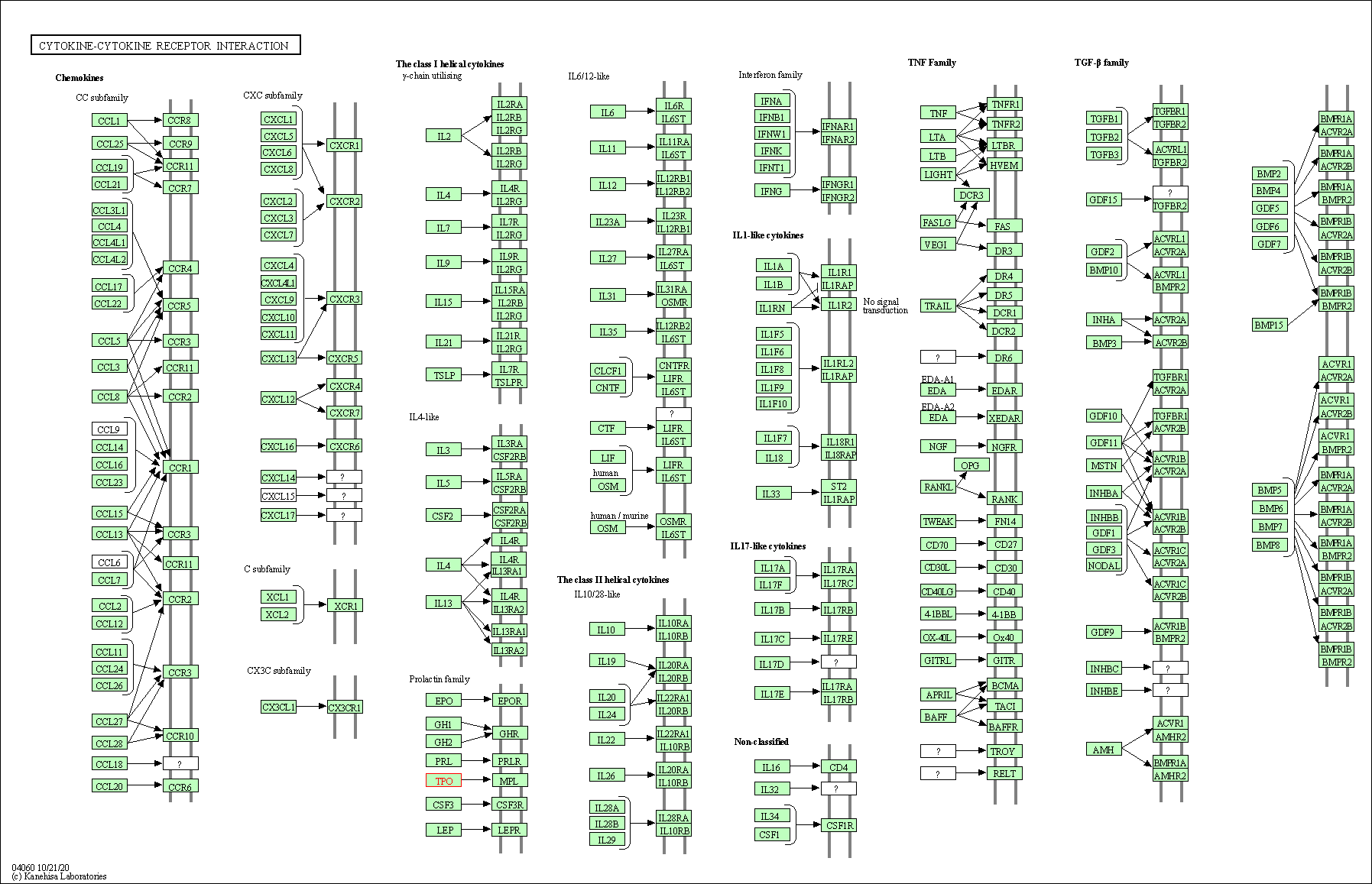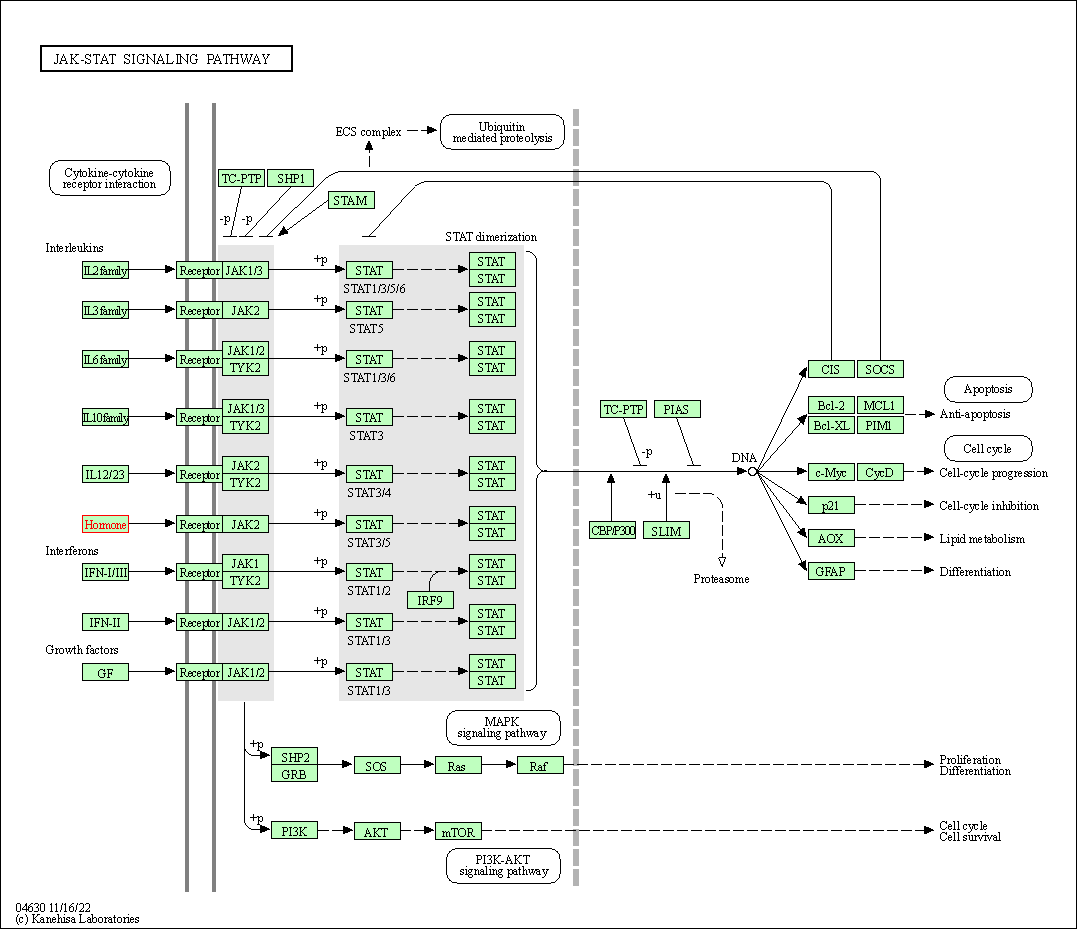Target Information
| Target General Information | Top | |||||
|---|---|---|---|---|---|---|
| Target ID |
T99379
|
|||||
| Target Name |
Thrombopoietin (THPO)
|
|||||
| Synonyms |
Myeloproliferative leukemia virus oncogene ligand; Megakaryocyte growth and development factor; Megakaryocyte colony-stimulating factor; ML; MGDF; C-mpl ligand
Click to Show/Hide
|
|||||
| Gene Name |
THPO
|
|||||
| Target Type |
Clinical trial target
|
[1] | ||||
| Disease | [+] 1 Target-related Diseases | + | ||||
| 1 | Thrombocytopenia [ICD-11: 3B64] | |||||
| Function |
Lineage-specific cytokine affecting the proliferation and maturation of megakaryocytes from their committed progenitor cells. It acts at a late stage of megakaryocyte development. It may be the major physiological regulator of circulating platelets.
Click to Show/Hide
|
|||||
| BioChemical Class |
EPO/TPO family
|
|||||
| UniProt ID | ||||||
| Sequence |
MELTELLLVVMLLLTARLTLSSPAPPACDLRVLSKLLRDSHVLHSRLSQCPEVHPLPTPV
LLPAVDFSLGEWKTQMEETKAQDILGAVTLLLEGVMAARGQLGPTCLSSLLGQLSGQVRL LLGALQSLLGTQLPPQGRTTAHKDPNAIFLSFQHLLRGKVRFLMLVGGSTLCVRRAPPTT AVPSRTSLVLTLNELPNRTSGLLETNFTASARTTGSGLLKWQQGFRAKIPGLLNQTSRSL DQIPGYLNRIHELLNGTRGLFPGPSRRTLGAPDISSGTSDTGSLPPNLQPGYSPSPTHPP TGQYTLFPLPPTLPTPVVQLHPLLPDPSAPTPTPTSPLLNTSYTHSQNLSQEG Click to Show/Hide
|
|||||
| 3D Structure | Click to Show 3D Structure of This Target | AlphaFold | ||||
| ADReCS ID | BADD_A06761 | |||||
| Drugs and Modes of Action | Top | |||||
|---|---|---|---|---|---|---|
| Clinical Trial Drug(s) | [+] 2 Clinical Trial Drugs | + | ||||
| 1 | A157 | Drug Info | IND submitted | Immune thrombocytopenic purpura | [2] | |
| 2 | BVI-007 | Drug Info | Phase 1 | Thrombotic stroke | [3] | |
| Mode of Action | [+] 2 Modes of Action | + | ||||
| Agonist | [+] 1 Agonist drugs | + | ||||
| 1 | A157 | Drug Info | [2] | |||
| Inhibitor | [+] 1 Inhibitor drugs | + | ||||
| 1 | BVI-007 | Drug Info | [1], [4] | |||
| Cell-based Target Expression Variations | Top | |||||
|---|---|---|---|---|---|---|
| Cell-based Target Expression Variations | ||||||
| Different Human System Profiles of Target | Top |
|---|---|
|
Human Similarity Proteins
of target is determined by comparing the sequence similarity of all human proteins with the target based on BLAST. The similarity proteins for a target are defined as the proteins with E-value < 0.005 and outside the protein families of the target.
A target that has fewer human similarity proteins outside its family is commonly regarded to possess a greater capacity to avoid undesired interactions and thus increase the possibility of finding successful drugs
(Brief Bioinform, 21: 649-662, 2020).
Human Pathway Affiliation
of target is determined by the life-essential pathways provided on KEGG database. The target-affiliated pathways were defined based on the following two criteria (a) the pathways of the studied target should be life-essential for both healthy individuals and patients, and (b) the studied target should occupy an upstream position in the pathways and therefore had the ability to regulate biological function.
Targets involved in a fewer pathways have greater likelihood to be successfully developed, while those associated with more human pathways increase the chance of undesirable interferences with other human processes
(Pharmacol Rev, 58: 259-279, 2006).
Biological Network Descriptors
of target is determined based on a human protein-protein interactions (PPI) network consisting of 9,309 proteins and 52,713 PPIs, which were with a high confidence score of ≥ 0.95 collected from STRING database.
The network properties of targets based on protein-protein interactions (PPIs) have been widely adopted for the assessment of target’s druggability. Proteins with high node degree tend to have a high impact on network function through multiple interactions, while proteins with high betweenness centrality are regarded to be central for communication in interaction networks and regulate the flow of signaling information
(Front Pharmacol, 9, 1245, 2018;
Curr Opin Struct Biol. 44:134-142, 2017).
Human Similarity Proteins
Human Pathway Affiliation
Biological Network Descriptors
|
|
| Protein Name | Pfam ID | Percentage of Identity (%) | E value |
|---|---|---|---|
| Rho GTPase-activating protein 44 (ARHGAP44) | 35.484 (33/93) | 1.00E-03 |



| KEGG Pathway | Pathway ID | Affiliated Target | Pathway Map |
|---|---|---|---|
| Cytokine-cytokine receptor interaction | hsa04060 | Affiliated Target |

|
| Class: Environmental Information Processing => Signaling molecules and interaction | Pathway Hierarchy | ||
| JAK-STAT signaling pathway | hsa04630 | Affiliated Target |

|
| Class: Environmental Information Processing => Signal transduction | Pathway Hierarchy | ||
| Hematopoietic cell lineage | hsa04640 | Affiliated Target |

|
| Class: Organismal Systems => Immune system | Pathway Hierarchy | ||
| Degree | 7 | Degree centrality | 7.52E-04 | Betweenness centrality | 4.20E-06 |
|---|---|---|---|---|---|
| Closeness centrality | 2.12E-01 | Radiality | 1.37E+01 | Clustering coefficient | 5.24E-01 |
| Neighborhood connectivity | 3.26E+01 | Topological coefficient | 2.45E-01 | Eccentricity | 12 |
| Download | Click to Download the Full PPI Network of This Target | ||||
| Target Affiliated Biological Pathways | Top | |||||
|---|---|---|---|---|---|---|
| KEGG Pathway | [+] 3 KEGG Pathways | + | ||||
| 1 | Cytokine-cytokine receptor interaction | |||||
| 2 | Jak-STAT signaling pathway | |||||
| 3 | Hematopoietic cell lineage | |||||
| References | Top | |||||
|---|---|---|---|---|---|---|
| REF 1 | Clinical pipeline report, company report or official report of the Pharmaceutical Research and Manufacturers of America (PhRMA) | |||||
| REF 2 | Clinical pipeline report, company report or official report of Klus Pharma | |||||
| REF 3 | Trusted, scientifically sound profiles of drug programs, clinical trials, safety reports, and company deals, written by scientists. Springer. 2015. Adis Insight (drug id 800027040) | |||||
| REF 4 | Clinical pipeline report, company report or official report of the Pharmaceutical Research and Manufacturers of America (PhRMA) | |||||
If You Find Any Error in Data or Bug in Web Service, Please Kindly Report It to Dr. Zhou and Dr. Zhang.

